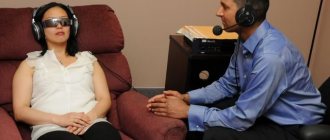Modern society should consist of mentally healthy, adequate people who are able to lead active life activities without experiencing personal discomfort. However, not everyone is able to cope with the accelerated pace of its development. The gradual depletion of the nervous system leads to the appearance of unpleasant symptoms, ranging from sleep disturbances to more complex mental pathologies, including hyposthenic neurasthenia. It is important to understand that such conditions in humans most often do not go away on their own.
Neurasthenic syndrome: what is it?
Neurasthenia is a painful condition of the nervous system that appears as a result of its exhaustion. Doctors often call this condition “irritable fatigue.” This term accurately characterizes neurasthenic syndrome.
A person who suffers from it feels both severe fatigue and at the same time incredible nervous excitability. People who lead an active lifestyle, putting social activities first, are especially susceptible to neurasthenia. They try to be on time in everything, which leads to chronic fatigue, for which there is no cure. In other words, neither sleep nor long rest can rid a person of this feeling. All that remains is to completely change your consciousness, and then, perhaps, your life will change.
Clinical forms of the disease
In the absence of proper treatment, the disease develops, the symptoms intensify and it becomes more severe. In total, there are three stages of astheno-neurotic syndrome:
- Hypersthenic form. At the initial stage of the disease, irritability, increased excitability, and emotional instability dominate. The child begins to raise his voice without reason, scream, and use rude speech. Attention becomes distracted, which leads to problems with studying and constant distraction by external stimuli. The patient begins to be haunted by dreams related to current problems and events of the day. Having difficulty falling asleep, he does not feel rested in the morning.
- Irritable weakness. The second stage of the disease, which occurs if adequate treatment has not been provided. Irritation intensifies, mental exhaustion increases. Having become easily excitable, the child shows bright bursts of temper, after which impotence sets in. Overexcitement gives way to grief, crying, feelings of fear or resentment. Concentration is very difficult for a child. Headaches and other discomfort occur in different parts of the body.
- Hyposthenic form. Sometimes it occurs in people belonging to the asthenic psychotype, but more often it develops as the third phase of the astheno-neurotic syndrome. The patient suffers from lethargy, increased mental and physical exhaustion, lack of mood, apathy, and passivity. Anxiety and feelings of sadness constantly haunt the child, which is why he is prone to touchiness, tearfulness, and complains about his mood and condition. It is difficult for him to concentrate both on studies and on physical labor.
In addition to the stages described, sometimes there is a stage of protracted neurosis, which often leads to the development of neurasthenia. A child at this stage exhibits severe hypochondria, indifference to what is happening around him, and a depressive state. He is prone to a constant feeling of fear and mood disorders. Over time, the condition worsens and turns into neurotic depression.
Astheno-neurotic syndrome can be an independent disease, but sometimes it becomes a harbinger of much more complex, intractable disorders (atypical depression, schizophrenia). Therefore, it is especially important to promptly consult a specialist when the first symptoms occur.
Causes of neurasthenia
The appearance of this disease can be caused by a large number of reasons. For example, they often refer to a lack of vitamins in the body, a decrease in the level of immunity, exposure to toxic substances, etc. Sometimes the disorder occurs as a result of metabolic disorders. However, the main cause of neurasthenic syndrome is an incorrect alignment and overestimation of mental capabilities. The development of the disease occurs due to constant stress, depression, anxiety, etc.
A person who works a lot will sooner or later feel excessively tired. The body simply stops resting, which causes exhaustion of the body’s nervous system. Neurasthenic syndrome (ICD 10 code - F48.0) contributes to the appearance of insomnia, irritability, and incomprehensible irascibility. By overloading your body, a person is exposed to significant risks, which in most cases are not justified.
Symptoms of the disease
Signs of neurasthenia include:
- chronic fatigue;
- weakness of the body;
- high irritability;
- sleep disturbance and lack of appetite.
It is also necessary to pay attention to heart problems, especially if there is a lack of air. The patient will feel that the heart is working very slowly and could stop at any moment, although the cardiogram often does not show any abnormalities. Acute pain in the heart area occurs, as well as intolerance to public transport, regular rocking and bouts of nausea.
Symptoms of neurasthenic syndrome manifest themselves in the form of headache and dizziness. It is possible to develop phobias, such as fear of enclosed spaces, fear of public speaking, etc. A person is constantly irritated, loses sleep, and panic occurs for no reason.
Doctors' recommendations
There are a number of actions that experts do not recommend taking when symptoms of neurasthenia are detected. Among them are the following:
- self-medication. Diagnosis of the disease should be carried out exclusively by a doctor. Medications, when taken spontaneously, can only aggravate the general condition or disguise it. In the future, this will create problems when diagnosing the disease;
- waiting for the spontaneous passage of mental deviation. Any disorders that occur in the cerebral cortex require specialist intervention. If you experience constant fatigue, irritability, which are accompanied by additional reactions of the body, such as rapid heartbeat, excessive sweating, sleep disturbances, etc., then this is a reason to consult a doctor;
- leaving your comfort zone. In order to find yourself in it, you must first go into it. If a person experiences inconvenience in any situation, he should not aggravate it further (by gyms, diets, etc.);
- Blame your environment for problems that arise. Neurasthenia is not a bad character, but a very real disease, during which a person can begin to blame himself and others for the fact that he has problems. In this case, the support and understanding of loved ones is very important, who will help correct the patient’s behavior. If necessary, you should consult a doctor or psychologist. Each of us has events in our lives that can serve as a trigger for the onset of pathology.
The true cause of neurasthenia lies in an innate vulnerability to mental illness. This only means that the individual is more sensitive and vulnerable to what is happening than others.
In order not to aggravate the problem, it is important to contact a specialist in a timely manner. This will make it possible to stop neurosis at the earliest stage of its development.
Stages of neurasthenic syndrome. Hypersthenic form
There are three stages of this disease, the most common of which is hypersthenic. At this stage, most patients feel completely healthy, and irritability and excitability are attributed to lack of sleep.
However, this develops a neurasthenic syndrome, and you need to pay more attention to this factor. Usually the patient gets angry at the slightest noise, he is irritated by the sound of conversations of passers-by, the signals of passing cars, etc. He often shouts at his interlocutors, turning to insults.
At the same time, the mental component is also not encouraging. The patient is unable to concentrate, as a result of which the level of performance decreases. Problems with sleep, heavy morning rises, a feeling of weakness, and headaches are characteristic of the hypersthenic form of the disease.
Symptoms and signs
At the initial stage, the disease manifests itself as severe irritability and emotional excitability. Any noise, loud conversations of others, laughter or a crowd easily makes a person angry. He screams and takes it out on relatives and colleagues. At the same time, he often realizes that he has failed. He explains everything by saying that he is tired and has a lot of work.
The disease at the next stage is characterized by:
- short-term active working condition;
- frequent distractions, especially during mental stress;
- excessive fussiness;
- tearfulness, which has not been observed before;
- intolerance;
- difficulty falling asleep, waking up at night.
Often there is a feeling of guilt and dissatisfaction with oneself. This leads to further exhaustion, which can be accompanied by anxiety and worry.
In asthenic neurosis, symptoms may decrease or increase depending on the emotional mood. There are often complaints of physical discomfort. Characteristic features are:
- headache that rings like a helmet;
- nausea, vomiting;
- heart pain;
- lack of appetite or selective eating;
- diarrhea or constipation.
The important point is that symptoms of physical illness arise or intensify during or immediately after a stressful situation. For example, after a scandal at home or at work, another stomach upset or severe heart pain may occur.
If such symptoms are severe, then “going into illness” is possible. A person becomes fixated on physical sensations and begins to suspect that he has terrible diagnoses.
Visits to doctors and detailed examinations do not find diseases that could lead to deterioration of well-being and constant fatigue. Physically, a person with asthenia is healthy.
Irritable weakness
This stage occurs if the patient has not made some effort to treat the first. In this case, the disease turns into pathology, life becomes simply unbearable. Neurasthenic syndrome is a depletion of the body, which is clearly manifested at this stage of the development of the disease. Moreover, in energetic people this disease manifests itself quite clearly. This is due to the fact that they are applying a lot of effort in the wrong direction.
At this stage, the patient is no longer ready to take on work. Hesitant attempts do not lead to positive results. On the contrary, fatigue and powerlessness immediately appear, which cannot be overcome. Lunch or rest breaks cannot help restore a person’s performance. Mood swings occur. Neurasthenic syndrome is characterized by irritability and weakness. There is a feeling of resentment due to the inability to do something, and sometimes tears appear. A person feels helpless, and therefore stress and depression arise.
Hyposthenic neurasthenia
This form is characterized by prolonged lethargy and passivity of the body. There is apathy, indifference, the patient does not want to start work. Neurasthenic syndrome is especially dangerous against the background of arterial hypertension, since high blood pressure does not have the most favorable effect on the body. Symptoms of neurasthenia, supplemented by an increase in blood pressure, have a detrimental effect on the human body.
The hyposthenic form of the disease can lead to complete recovery. Due to weakness and inactivity, the body rests and gradually accumulates strength. At one point it is restored, and the person can return to normal life. Situations often occur when a patient, having gotten rid of neurasthenia, again behaves the same way as before. Because of this, a relapse occurs, and the disease returns in a more severe form. A person becomes inadequate, and causeless depression is replaced by an increase in the general tone of the body and excessive optimism.
Neurasthenia in women
It is quite difficult to accurately determine the picture of this disease in the fairer sex, since the symptoms manifest themselves differently, and in very rare cases the disease develops in the same way. Common signs include indifference, bitchiness, and momentary mood swings.
Most often, a woman suffering from neurasthenic syndrome looks quite calm outwardly and does not show her emotions. She takes failures hard, does not want to listen or understand anything, and often tries to prove that she is right. This causes problems both at home and at work. The inability to rest properly leads to chronic fatigue. Then there is dissatisfaction with oneself, inhibition of thoughts and uncertainty.
In addition, sexual neurasthenia is sometimes observed, which is characterized by difficulties in the sexual sphere due to nerves. It appears due to sexual dissatisfaction or mistrust of the partner.
Neurasthenia
Internal culture, good manners and restraint are the basis for control over a critical situation.
Restraint in expressing your feelings is not harmful - neither for physical nor for mental health. Allowing yourself to experience emotions is not harmful, but you should never show them in society. Letting out your anger—something many psychologists encourage—usually only makes the situation worse. According to research by B. Bushman, a professor at the University of Iowa, taking out anger on an inanimate object does not reduce stress, but just the opposite. Psychologist J. Bonanno from Columbia University showed that people who practice control over emotions in life, who know how to restrain them when necessary, are less susceptible to life stress than others. In order for you to stop having attacks of anger, you need to change your character, become calm and restrained. Sometimes it seems unrealistic, incredible, impossible, but it is not so. Character is a set of habits, and habits can be changed. If you set yourself this task and start training calm reactions, you will succeed. The main thing is not to forget about your intention to restrain yourself and be calmer. Restraint and the ability to control your emotions are wonderful qualities, but this should not be confused with suppressing emotions. Suppression is carried out in relation to strong, violent, unruly emotions, this is an attempt to contain the volcano, leading to even greater explosions. Suppressing already developed emotions is a rather harmful thing. How to preserve your health in a tense situation? Anyone who does not take care of his health in a tense situation is not acting prudently. Headaches, fatigue and failures in personal and business life can lead to increased irritability, neuroses and neurasthenia. Neurosis
Material https://www.psychologos.ru/articles/view/nevroz Neurosis (not clinical, but in the field of practical psychology) is one of the states of mental illness, an easy fall into negativity and difficulty getting out of negativity. Getting stuck in negativity. A state of strong dissatisfaction (“Everything is bad”) and a desire to escape from this state (as opposed to apathy, when the state of “everything is bad” becomes familiar). Neurosis is usually accompanied by dissatisfaction with oneself and a decrease in self-esteem, irritability, dependence on others, indecision and at the same time a tendency to impulsive reactions. Artificial neuroses Neurosis can also be created artificially, playing on the creation of desire and alternately alternating the feeling of just about success and “Damn, bummer...” - watch a video clip from the film Amelie, where a love neurosis is created. Love neurosis Love neurosis is a type of neurosis that arose on the basis of love relationships, sometimes created to promote love relationships. Neurosis and the neurotic A neurotic is not completely mentally healthy, but it is not obvious that he is sick. At the neuroticism stage, a person is considered healthy. Numerous characters in emotional television series are typical neurotics. If neuroticism intensifies to the point of real neurosis (see Neurosis in the clinic), we can already speak of a disease. Neurosis in the clinic Neurosis in the clinic: a collective name for a group of functional psychogenic reversible disorders that tend to be protracted. The clinical picture of such disorders is characterized by asthenic, obsessive and/or hysterical manifestations, as well as a temporary decrease in mental and physical performance.
Material from Wikipedia - the free encyclopedia Neurasthenia
Neurasthenia is a mental disorder from the group of neuroses, manifested in increased irritability, fatigue, and loss of the ability for prolonged mental and physical stress. The occurrence of neurasthenia is facilitated by infections and intoxications that weaken the body (alcohol, smoking), endocrine disorders, malnutrition, etc. Symptoms and course There are 3 stages (forms) of neurasthenia: Hypersthenic neurasthenia The initial stage, the most common form, manifests itself mainly in irritability and excitability, with in which the disease debuts, it is manifested by increased mental excitability and pronounced irritability. Patients are irritated by the slightest noise, conversations of others, any sounds, rapid movement of people, just a crowd of people around, crowded gatherings. They are easily irritated, shout at loved ones, co-workers, interlocutors, are capable of insulting, that is, they easily lose their composure, and are very impatient. Along with this, the performance of patients is reduced, but not only due to fatigue, but at this stage of the disease, mainly due to their mental lack of composure, absent-mindedness, inability to concentrate on the required range of ideas and start the necessary work, that is, due to the primary weakness of the active attention. Having started the lesson, the patient cannot withstand the mental tension required here for a long time, again - the tension of active attention. He gets up from the table, leaves the workplace, is distracted by extraneous stimuli, then again there is a “difficult start” to the lesson, and so on many times, due to large losses of time, labor productivity is negligible. Sleep disturbances are always pronounced: the patient has difficulty falling asleep, often wakes up, falls asleep again, experiencing abundant dreams inspired by daytime worries. As a result, in the morning he gets up late and with difficulty, not rested, with a heavy, “fuzzy” head, in a bad mood, with a feeling of fatigue and weakness, which somewhat recedes only in the evening. There are frequent complaints of headache, general weakness, poor memory, and discomfort in various parts of the body. Patients experience heaviness in the head, a feeling of pressure in the temples, and girdling headaches (“neurasthenic helmet”). Irritable weakness Second, intermediate, stage (phase of the disease). It is characterized by so-called irritable weakness (the main clinical content of the second form of neurasthenia) - a combination of increased excitability and irritability with fatigue and rapid exhaustion. For random and insignificant reasons, the patient experiences violent reactions of irritation or outbursts of excitement, which are usually short-lived, but frequent. Increased excitability is often expressed in tearfulness, which was previously not characteristic of the patient, or in impatience and fussiness. Characterized by painful intolerance to loud sounds, noise, bright light, and strong odors. The ability to control the external manifestations of one’s emotions is lost. Active attention is upset. Complaints of absent-mindedness and poor memory appear. Unstable mood, with a tendency to depression. In severe forms of neurasthenia, a picture of so-called exhaustion depression may develop: patients are gloomy, lethargic, and indifferent to everything. A constant sign of neurasthenia is sleep disturbance: difficulty falling asleep, shallow or unrefreshing sleep, disturbing dreams, drowsiness during the day and insomnia at night. Appetite decreases or completely disappears, belching, heartburn, constipation, and a feeling of heaviness in the stomach appear. There are frequent complaints of headaches, palpitations, a feeling of a sinking heart, possible disorders of sexual function, etc. Irritable weakness is the main clinical content of the second form of neurasthenia (or the second phase of the disease), which can manifest itself in subjects of an unrestrained, choleric temperament or in persons with a strong and balanced type of nervous system in cases where recovery at the hypersthenic stage did not occur, and the pathogenic situation persists. Hyposthenic neurasthenia Third stage. Weakness and exhaustion predominate. The main symptoms are lethargy, apathy, increased drowsiness, depression. Patients are not able to mobilize themselves for work effort; they constantly experience a feeling of great fatigue, depressed by thoughts about their somatic sensations. At this stage of the disease, there is constant massive asthenia against a background of low mood. The background mood is somewhat alarming, with a tinge of sadness and weakening interests. There are no affects of melancholy or anxiety; the low mood is neurotic in nature, permeated with asthenia and characterized by tearfulness and emotional lability. Hypochondriacal complaints and fixation of patients on their internal sensations are frequent. Over time (especially under the influence of treatment), patients' sleep improves, which, in essence, is where the healing process begins. It should be noted that with repeated attacks of neurasthenia (in any of its forms, especially the last one), the duration of the attacks increases, and depressive phenomena, deepening, are increasingly approaching the cyclothymic level. In this regard, even old authors (N. Schule, R. Kraft-Ebing, S. S. Korsakov, A. V. Kannabikh) pointed to the possibility of periodic neurasthenia. This is consistent with the latest data from clinical experience on the possibility of such periodic manifestations of neurasthenic depression developing into cyclothymia. Treatment Treatment of neurasthenia in the initial stage is aimed at streamlining the work and rest regime, eliminating the cause of emotional overstrain, and general strengthening of the body (regular nutrition, vitamin therapy, restorative treatment, psychotherapy). If necessary, change jobs. In severe cases (hyposthenic neurasthenia), hospital treatment and the use of antidepressants and tranquilizers along with general restoratives are indicated. The prognosis is favorable
Neurosis in the clinic
Material https://www.psychologos.ru/articles/view/nevroz_v_... Neurosis in the clinic (synonyms - psychoneurosis, neurotic disorder): a collective name for a group of functional psychogenic reversible disorders that tend to have a protracted course. The clinical picture of such disorders is characterized by asthenic, obsessive and/or hysterical manifestations, as well as a temporary decrease in mental and physical performance. The concept of “neurosis” was introduced into medicine in 1776 by the Scottish physician William Cullen. The psychogenic factor in all cases is conflicts (external or internal), the effect of circumstances causing psychological trauma, or prolonged overstrain of the emotional and/or intellectual spheres of the psyche. I. P. Pavlov, within the framework of his physiological teaching, defined neurosis as a chronic, long-term disorder of higher nervous activity (higher nervous activity), caused by overstrain of nervous processes in the cerebral cortex by the action of external stimuli of inadequate strength and duration. The use of the clinical term “neurosis” in relation not only to humans, but also to animals at the beginning of the 20th century caused a lot of controversy. The term has undergone numerous revisions and has not yet received a clear definition. In addition, it is worth noting that in medicine and biology, “neurosis” can be called various functional disorders of the internal nervous system. Forms of neuroses in the clinic Traditionally, three forms of neuroses have been distinguished: Neurasthenia Hysteria Obsessive-compulsive neurosis Neurasthenia is characterized by irritability, weakness of the nervous system, and frequent headaches. There is a weakening of attention and mental fatigue. There are no characteristic trends regarding personality changes; pathogenicity and a decrease in volitional qualities are observed. An increasing deterioration in concentration results in disability, the same effect is observed with increased fatigue. With neurasthenia, sleep and sexual disturbances often occur. Neurasthenia is typical for people with a weak or strong unbalanced (uncontrolled) type of higher nervous activity, average in relation to signaling systems. Hysteria, acquired as a result of mental trauma, manifests itself in motor disorders (paralysis, etc.), speech disorders, sensory disorders (hysterical blindness, loss of smell and hearing, hyperesthesia and hypoesthesia), autonomic disorders (intestinal obstruction, bloating, hysterical vomiting, anorexia), mental disorders (psychogenic amnesia, increased suggestibility). A person suffering from hysteria will have an inadequately inflated level of aspirations; he is characterized by egocentrism, vanity, pretentiousness and conflict. Hysteria is characteristic of people with a weak type; subcortical activity predominates. Obsessive-compulsive disorder is the most difficult form of neurosis to treat. Formed as a result of a traumatic situation. With obsessive-compulsive neurosis, the individual exhibits timidity, timidity and self-doubt. Obsessive doubts, ideas, actions, fears appear. It is characterized by pathological inertia of nervous processes, in people with a pronounced orientation towards the second signaling system. Symptoms General psychological symptoms General neurotic weakness Tendency to reflect Dependence on others Indecisiveness Low self-esteem Dissatisfaction with oneself Inconsistency of the image of “I” Emotional distress Low awareness of contradictions and conflicts General neurotic symptoms State of neuropsychic weakness (asthenia) Anxiety, restlessness Sleep disturbances Dull constant headache Heart pain, psychology (psychological experience of pain) General decrease in performance Emotional lability Impatience Various autonomic disorders: lability of pulse, blood pressure, increased sweating, dysfunction of the gastrointestinal tract (bear disease). Neurosis in detail NEUROSIS, or neurotic disorder, is a state of emotional distress, manifested by a variety of psycho-emotional, somatic and behavioral symptoms. In mild cases, somatic and mental functions remain generally intact. In more severe cases, more pronounced impairments occur, which can lead to loss of ability to work. Origin According to the traditional psychotherapeutic point of view, coming from the work of Freud, neuroses (or psychoneuroses) are generated by unconscious internal conflicts. These may be conflicts between two opposing desires or between desires and social norms of behavior. People who are unable to resolve these conflicts within themselves suppress them, pushing them out of the sphere of consciousness. As a result, conflicts seem to be “forgotten.” But the “forgotten”, consisting of repressed mental processes, painful and unpleasant memories, retains its dynamic potential and character. The conflict, pushed into the deep, unconscious layers of the psyche, does not fade; it actively influences a person’s thinking, feelings and behavior “from within.” The term "neurosis" is sometimes used to designate this neurotic process as the psychological mechanism that produces the corresponding symptoms. A number of psychiatrists challenge the Freudian concept of neuroses, trying to prove that the origins of neurosis are behavioral, akin to a bad habit that can be overcome by resorting to behavioral therapy methods. Attempts are also being made to explain the development of neuroses in terms of cognitive (i.e., psychologically based cognitive processes) or biological models, as well as models of social learning. Symptoms Normally, a person usually does not have deep mental conflicts that negatively affect his performance and ability to love someone other than himself. Overcoming adversity and suffering does not significantly affect a person’s personality. A neurotic personality deviates from the norm in these characteristics and is often completely unable to cope with the problems that arise. Contrary to popular belief, imagination does not play a significant role in neurotic conditions. Frequent complaints about various somatic and non-somatic symptoms, such as anxiety, headache, dizziness, fatigue, indigestion, palpitations, pain, shortness of breath, insomnia, etc., are not a figment of the imagination of patients. Although these symptoms are not based on any organic disease or damage, they are very real and usually increase sharply during emotional turmoil or severe nervous tension. A very common symptom is pathological fatigue, which is not relieved by rest and is unexplained by physical causes. The most important symptom of neurosis is anxiety. Many neurotic patients are often haunted by the fear of going crazy, or contracting an infectious disease, especially a sexually transmitted disease, fear of cancer or heart disease, death or suicide, fear of people or animals. Although in most of these patients the fear has no obvious cause, it constantly debilitates them. Anxiety is a state of chronic fear, premonitions of terrible misfortune that fill the lives of patients. Attacks of acute anxiety can occur suddenly and are so intense that they are accompanied by severe panic and a feeling of horror. Treatment Patients with emotional disturbances and personality problems, as well as other neurotic disorders, are often helped by psychotherapy (psychological treatment). Its goal is to make an emotionally disturbed person a happier, more mature and stable person. The most intensive form of psychotherapy is psychoanalysis, which uses special techniques such as the method of free association, dream analysis, fantasy interpretation, etc. Another psychotherapeutic approach is group therapy. Patients are grouped into small therapeutic groups, in which the psychotherapist plays a leading role. Dynamic relationships quickly develop between the therapist and the group, as well as between individual group members. Various psychodynamic factors (identification, resistance, hostility, competition, avoidance mechanisms) come to the surface in the process of interaction and can be identified, explained and ultimately overcome. Tranquilizers are also used in the treatment of patients with neuroses. Many of these psychoactive drugs have become very popular and widely used to help patients cope with troubling symptoms and feel well enough to work, sleep, or at least function better than before. However, these drugs should be used sparingly, since they, while not curing the underlying process, have many undesirable side effects. A relatively recently developed treatment method is behavioral therapy, based on the development of certain conditioned reflexes; its success often depends on the patient's ability to achieve complete physical relaxation (relaxation). Behavioral therapy sometimes uses negative sanctions (such as electric shocks) to eliminate unwanted actions or habits. Classification Referring to the existing disagreement among specialists regarding the definition of the term “neurosis,” the Diagnostic and Statistical Manual of Mental Health Disorders (DSM), developed by the American Psychiatric Association, does not classify neurosis as a separate diagnostic category, but considers it as a component of a number of mental disorders.
Which emotions are voluntary and which are not?
Material https://www.psychologos.ru/articles/view/kakie_emo... Involuntary emotional reactions appear involuntarily, uncontrollably, and signal to an attentive person what a person really feels. Emotions often arise in the wrong place, in the wrong place, at the wrong time or with the right intensity. The usual reaction is not always the most appropriate response; sometimes you can hurt other people with your emotions. When we are overwhelmed with emotions, we think much worse than in a calm state. Sometimes you just need to relax, and then there is no need for unnecessary emotions. It is useful for a developed personality to be able to manage emotions. This sincere emotion is completely under control and solves the problem. Rage will help knock out information - that means there will be rage. Only some psychiatrists' clients do not know how to manage their emotions; normal people with intact psyches can manage their emotions, just not all of them and not always. Most children, from the age of three or four, at the request of their parents, can easily both cry and laugh, be surprised or offended. When playing among themselves, children - and especially girls - express emotions clearly, adequately and convincingly. The whole question is that sometimes it turns out to be difficult to cope with certain emotions: it is difficult not to get angry when you are angry, it is difficult to remove resentment when it has already flared up in your soul. The task of managing emotions usually turns out to be difficult precisely because it is posed by people who have already missed the moment of the emergence of emotions, who did not prevent this occurrence, who did not prevent the actions of other people who created these emotions for them. At the same time, if a person moves into a more active, leadership position and triggers his own and other people’s emotions himself before the waves of other people’s emotions pour on him, he no longer needs to manage his emotions. He got ahead and controls the situation himself. Managing emotions is a matter of education. It is a well-mannered person who differs from an ill-mannered person primarily in that he knows how to control his emotions even where it is difficult and not desirable. A developed personality controls his emotions, knows how to manage his emotions and states, and knows how to control himself. Actors, Indians, diplomats and other people who have undergone special training control their emotions much better than ordinary people who do not have such training. Every person can develop the ability to manage their emotions if they set themselves such a task. The main thing is desire and training.
Neurasthenic syndrome in children
Although children in most cases are not exposed to the same level of workload as adults, a child can also develop neurasthenia. There are the following forms of this disease in childhood:
- Fear disorder. The child experiences unexpected attacks of fear, which can last up to half an hour. The baby is afraid to be left alone in the dark and gloomy rooms.
- Hysterics. They usually affect children aged 4 to 6 years. They are expressed in falling to the floor and crying loudly.
- Stuttering. Oddly enough, this phenomenon also applies to forms of neurasthenia. After all, stuttering appears as a result of significant fright.
- Sleep problems. The child cannot sleep, he is afraid of nightmares at night, and sometimes sleepwalks.
- Enuresis. Quite common in children, it is characterized by unconscious urination, mainly at night.
Neurasthenic syndrome in children has many manifestations, and its treatment directly depends on the correctly identified cause.
Forecast
The prognosis depends on the stage of the disease and its duration. In the initial stage, as well as with a short duration of the disease (up to 3 - 6 months), the prognosis is favorable. With long-term Neurasthenia, recovery may be accompanied by residual neurotic disorders in the form of sharpening of premorbid character traits and increased sensitivity to new psychotraumatic influences. In case of an insoluble psychotraumatic situation and “pathologically altered soil” (asthenic character traits, residual organic cerebral insufficiency, etc.), an unfavorable course of N. is possible with a transition to neurotic personality development.
Diagnosis of the disease
It is quite difficult to correctly determine the exact diagnosis of neurasthenia. The decision is based on the patient’s complaints, a thorough external examination, and the use of instrumental methods. With their help, you can immediately eliminate chronic diseases, various infections, and somatic lesions. However, you need to make sure that there is no brain injury. To do this, a computed tomography scan should be performed.
Diagnosis of neurasthenic syndrome is made on the basis of complete trust between the patient and the doctor. The doctor in this case acts as a psychologist. The patient needs to be told about everything that worries and torments him. The fact is that the analysis of neurasthenia cannot be carried out using special studies; the diagnosis is made solely on the patient’s stories and certain criteria.
Diagnosis of neurasthenia
The diagnosis is made by a doctor based on the patient’s complaints, neurological examination and medical history. Differential diagnosis includes the exclusion of somatic diseases, intoxication, chronic infections, in which neurasthenia often becomes one of the first symptoms. Since neurasthenia can develop against the background of organic brain damage, the doctor may prescribe an MRI or CT scan of the brain. Assessment of cerebral circulation is carried out using the rheoencephalography procedure. Consultations with a psychologist and psychiatrist may also be required.
Treatment
There are several ways to treat neurasthenic syndrome. The most effective are those that are aimed at restoring the patient’s mental state. An excellent solution would be to conduct a hypnosis and relaxation session. Here the patient learns to think positively, as well as control his actions and actions.
Sometimes the doctor prescribes medications to treat neurasthenic syndrome. A specific course of therapy is created, which includes taking medications. Most often these are antidepressants and biological stimulants.
Treatment should be accompanied by proper nutrition, as well as minimizing mental and physical stress. It is necessary to explain to the patient that peace and rest are needed, and daily walks and outdoor games have never harmed anyone.
At home, therapy is often not as effective as in a special institution. The fact is that the everyday component irritates the patient and reminds him of problems. Therefore, if possible, it is better to undergo treatment outside of home.
Treatment of asthenic neurosis
Treatment of any disease must begin with establishing its cause. To do this, consult a psychotherapist or psychiatrist. At the initial stage, the following recommendations give good results:
- Adjustment of work and rest schedule.
- Enriching the diet with fresh fruits and vegetables.
- Strong physical activity. This is walking, walks in the park, swimming.
- Taking multivitamin complexes.
- Wellness and/or physiotherapeutic procedures.
For asthenic neurosis, treatment includes the prescription of medications. Depending on the symptoms, the doctor individually selects a drug to restore sleep and normalize heart function. To reduce anxiety and excitability, sedatives are prescribed.
The use of psychotherapeutic techniques for neurasthenia is effective. Individual or group psychotherapy sessions help a person identify the true psychological cause that became the trigger for the disorder. In psychotherapy, the client is taught skills to deal with stress, which he then actively uses in life.
Folk remedies for treatment
Self-therapy is usually discouraged without the approval of a doctor. Neurasthenic syndrome is no exception. However, you can use the following remedies in the early stages of the disease or together with complex treatment:
- Herbal decoction. Thyme, drupes or bearberry are commonly used because they have soothing properties. The herb (dry and crushed) must be poured with boiling water and cooked for about 5 minutes. This decoction is used 1 tbsp. spoon several times a day.
- Herbal infusion. The cooking principle is the same, only this solution does not need to be boiled, but simply cover with a lid and let it brew. Hawthorn fruits and lingonberry leaves are perfect here.
- Tincture. This liquid is infused with high-quality vodka. This medicine sits in a dark place for about 10 days before being ready for use. 15-20 drops before meals 3 times a day.
Massage as a treatment
This method of therapy is not the main one, but is perfect in combination with the main course of treatment. The main purpose of massage is to relax the body, improve blood circulation and the functioning of internal organs.
Movements should be smooth so that the patient feels relaxed. It is not recommended to use claps or strikes with the edge of the palm. The average duration of a massage course is about two weeks, 20 minutes daily. Sometimes it is appropriate to conduct a session in a dark room if the patient is very tired, both mentally and physically.
Diagnostics
Diagnosing neuroses involves a correct assessment of symptoms. First of all, it is necessary to exclude other diseases that have similar somatic symptoms to neuroses. These are diseases of human internal organs.
Diagnosis of neurosis is quite difficult due to the lack of objective and practical indicators that would describe the picture of the disease. The doctor cannot prescribe tests, since neuroses cannot be diagnosed through examinations using special medical equipment.
The disease is diagnosed using a color technique. All colors take part in the technique, and a neurosis-like syndrome manifests itself when choosing and repeating purple, gray, black and brown colors. Hysterical neurosis is characterized by the choice of only two colors: red and purple, which 99% indicates the patient’s low self-esteem.
To diagnose neurosis, you will need an experienced doctor who will interview the patient and make a final conclusion. To exclude diseases of internal organs, examination in a hospital is allowed.
“How to cure neurosis if it is a mental disorder and not a physical manifestation?” is a fairly common question among users who have symptoms of the disease both in themselves and in their children.
Prevention
According to ICD 10, neurasthenic syndrome manifests itself in severe fatigue after overload. Therefore, the main preventive measure will be adherence to a daily routine, a clear distinction between work and rest. If a stressful situation occurs, you need to find a way out and no longer be exposed to this risk.
When creating a daily routine, you need to pay attention to setting rest times. It is advisable that full sleep lasts 8 hours, and it is recommended to go to bed and get up at the same time every day. You should avoid conflicts and do not try to do all the work in one day. It must be remembered that avid workaholics are considered the main candidates for the development of neurasthenic syndrome.
Therapy
Timely diagnosis of neuroses makes it possible to make favorable prognoses for their treatment. The main role in this is played by activities that help eliminate or minimize factors that have a negative impact on the human psyche. At the same time, the doctor optimizes the patient’s activity schedule, paying special attention to proper rest.
The psychotherapeutic work that a specialist conducts with a patient is aimed at explaining and teaching all constructive forms that make it possible to counteract external factors that are irritants. The specialist coordinates all manipulations with the patient: he identifies the negative circumstances that provoked the onset of the disorder, minimizes their impact on the person, using constructive methods for this.
Among the recommended activities that have a beneficial effect on neurasthenics are the following:
- adherence to daily routine;
- periodic, high-quality and sufficient rest;
- compliance with nutritional recommendations. The menu should contain products that contain the maximum amount of nutrients;
- the presence of daily physical activity, which must be performed regardless of the patient’s wishes;
- a contrast shower has proven itself well, which invigorates and tones;
- breathing exercises that allow you to relax without losing concentration. It helps you focus on yourself and your feelings.
In some cases, drug treatment is also used. It consists of taking vitamin-mineral complexes, sedatives and tonics of plant origin. For hyposthenic neurasthenia, tranquilizers and antipsychotics may be prescribed. The wide spectrum of action of such drugs requires a qualified and competent approach, which can only be provided by a professional doctor after a thorough examination of the patient.









